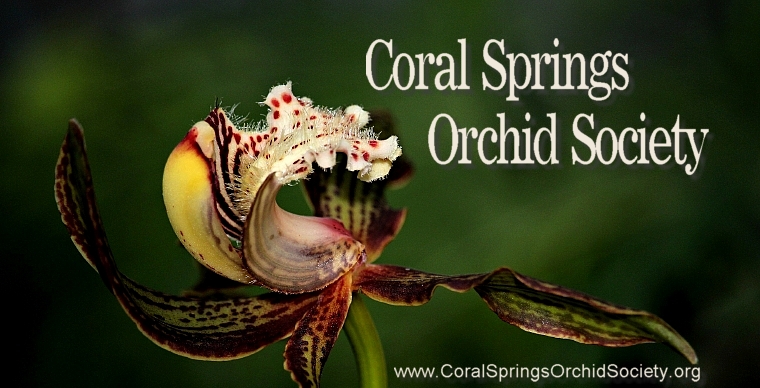



...

© Copyright 2013 - 2018 Coral Springs Orchid Society. All rights reserved.
Light
Most Oncidiums like moderately low light, similar to Phalaenopsis orchids. These tend to be the bulbous type Oncidiums, Psychopsis "butterfly orchids" and intergeneric crosses. Terete leaved, equitant and "mule ear" Oncidium orchids like brighter light, similar to Cattleyas.
Water
Oncidiums generally like to dry out between waterings. Adjust your watering schedule to the time of year and the growing location.
Indoors, Oncidiums need to be watered about once a week. We recommend putting the plant in the sink and letting water run through for about a minute. Let the plant drain in the sink before putting it back into its decorative container.
Outside, the watering schedule depends on the season. In summer, plants may need to be watered every other to every third day. In spring and fall, two waterings a week is usually ample. in winter, reduce waterings to once-a-week.
This is a fairly standard watering routine for most orchids. Newly mounted plants may need daily watering. Mounted plants may also need daily watering in very hot weather.
Fertilizer
Oncidiums are light feeders and require less fertilizer than most orchids. In fact, their leaves can develop tip burn from exuding excess salts when the plants are overfed.
Once-a-month feeding at regular strength during most of the year is adequate. In the summer, twice-a-month feedings at half strength seems to work better and cause less tip burn. Any general purpose water soluble fertilizer is recommended.
Media
Oncidiums tend to be fine-rooted and therefore like a loose, well-drained media. Since the roots are fine, the components of the mix should also be on the small side. A blend of coarse Afilator and fine charcoal works well. Coconut peat (10% to 15% by volume) can be added to increase water holding properties where drying is a problem.
Many Oncidiums do well mounted (e.g. on tree fern or cork bark), particularly equitants and terete leaved types.
Repotting
Should be done in the spring, before temperatures get too high. The fine roots of Oncidiums rot very quickly when potting media breaks down. It is important to repot on a regular schedule, usually every two years. Be careful not to overpot. Allow enough room for two years growth, but no more.
Diseases
Most plant diseases are caused by damp or stagnant conditions. Plants grown outside during the rainy season are very prone to bacterial rot. Proper watering habits and protection from excessive rain is the best prevention for disease.
To treat fungal disease, we recommend Physan, RD-20, Kocide, Aliette, Manzate or other brands of these chemical groups.
Pests
Against insects like scale, mealy bugs and spider mites, most good pesticides that are labeled for plants will work on Oncidiums. Powders and water-based pesticides tend to work better than oil-based ones. Spraying should be done after watering and during the cooler part of the day.
